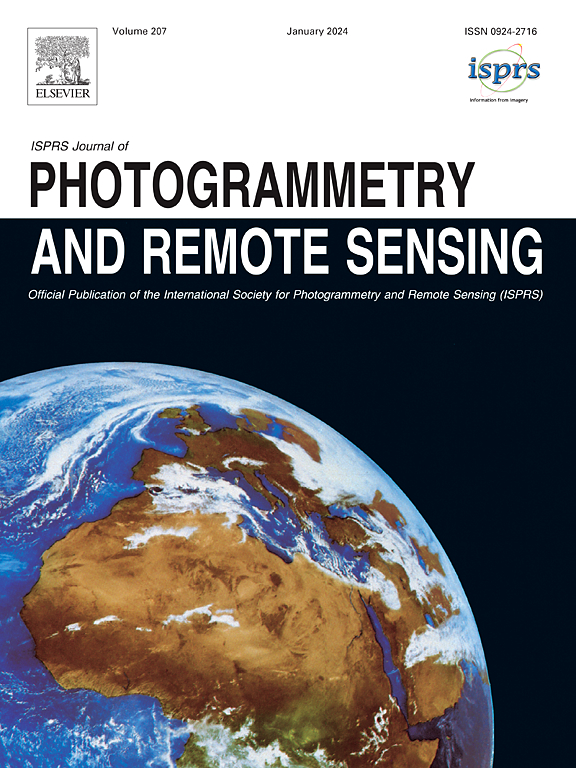PolyR-CNN: R-CNN for end-to-end polygonal building outline extraction
IF 10.6
1区 地球科学
Q1 GEOGRAPHY, PHYSICAL
ISPRS Journal of Photogrammetry and Remote Sensing
Pub Date : 2024-10-18
DOI:10.1016/j.isprsjprs.2024.10.006
引用次数: 0
Abstract
Polygonal building outline extraction has been a research focus in recent years. Most existing methods have addressed this challenging task by decomposing it into several subtasks and employing carefully designed architectures. Despite their accuracy, such pipelines often introduce inefficiencies during training and inference. This paper presents an end-to-end framework, denoted as PolyR-CNN, which offers an efficient and fully integrated approach to predict vectorized building polygons and bounding boxes directly from remotely sensed images. Notably, PolyR-CNN leverages solely the features of the Region of Interest (RoI) for the prediction, thereby mitigating the necessity for complex designs. Furthermore, we propose a novel scheme with PolyR-CNN to extract detailed outline information from polygon vertex coordinates, termed vertex proposal feature, to guide the RoI features to predict more regular buildings. PolyR-CNN demonstrates the capacity to deal with buildings with holes through a simple post-processing method on the Inria dataset. Comprehensive experiments conducted on the CrowdAI dataset show that PolyR-CNN achieves competitive accuracy compared to state-of-the-art methods while significantly improving computational efficiency, i.e., achieving 79.2 Average Precision (AP), exhibiting a 15.9 AP gain and operating 2.5 times faster and four times lighter than the well-established end-to-end method PolyWorld. Replacing the backbone with a simple ResNet-50, PolyR-CNN maintains a 71.1 AP while running four times faster than PolyWorld. The code is available at: https://github.com/HeinzJiao/PolyR-CNN.
PolyR-CNN用于端到端多边形建筑轮廓提取的 R-CNN
多边形建筑轮廓提取是近年来的研究重点。现有的大多数方法都是通过将其分解为多个子任务并采用精心设计的架构来完成这项具有挑战性的任务。尽管这些方法非常精确,但在训练和推理过程中往往效率低下。本文提出了一种端到端框架(称为 PolyR-CNN),它提供了一种高效且完全集成的方法,可直接从遥感图像中预测矢量化建筑多边形和边界框。值得注意的是,PolyR-CNN 只利用感兴趣区域(RoI)的特征进行预测,从而减少了复杂设计的必要性。此外,我们还提出了一种新颖的 PolyR-CNN 方案,从多边形顶点坐标中提取详细的轮廓信息(称为顶点建议特征),以指导 RoI 特征预测更多规则建筑物。PolyR-CNN 在 Inria 数据集上通过简单的后处理方法展示了处理带洞建筑物的能力。在 CrowdAI 数据集上进行的综合实验表明,与最先进的方法相比,PolyR-CNN 实现了具有竞争力的准确性,同时显著提高了计算效率,即实现了 79.2 的平均精度(AP),显示出 15.9 的 AP 增益,运行速度比成熟的端到端方法 PolyWorld 快 2.5 倍,重量轻 4 倍。用简单的 ResNet-50 代替骨干网后,PolyR-CNN 保持了 71.1 的平均精度,同时运行速度比 PolyWorld 快四倍。代码见:https://github.com/HeinzJiao/PolyR-CNN。
本文章由计算机程序翻译,如有差异,请以英文原文为准。
求助全文
约1分钟内获得全文
求助全文
来源期刊

ISPRS Journal of Photogrammetry and Remote Sensing
工程技术-成像科学与照相技术
CiteScore
21.00
自引率
6.30%
发文量
273
审稿时长
40 days
期刊介绍:
The ISPRS Journal of Photogrammetry and Remote Sensing (P&RS) serves as the official journal of the International Society for Photogrammetry and Remote Sensing (ISPRS). It acts as a platform for scientists and professionals worldwide who are involved in various disciplines that utilize photogrammetry, remote sensing, spatial information systems, computer vision, and related fields. The journal aims to facilitate communication and dissemination of advancements in these disciplines, while also acting as a comprehensive source of reference and archive.
P&RS endeavors to publish high-quality, peer-reviewed research papers that are preferably original and have not been published before. These papers can cover scientific/research, technological development, or application/practical aspects. Additionally, the journal welcomes papers that are based on presentations from ISPRS meetings, as long as they are considered significant contributions to the aforementioned fields.
In particular, P&RS encourages the submission of papers that are of broad scientific interest, showcase innovative applications (especially in emerging fields), have an interdisciplinary focus, discuss topics that have received limited attention in P&RS or related journals, or explore new directions in scientific or professional realms. It is preferred that theoretical papers include practical applications, while papers focusing on systems and applications should include a theoretical background.
 求助内容:
求助内容: 应助结果提醒方式:
应助结果提醒方式:


